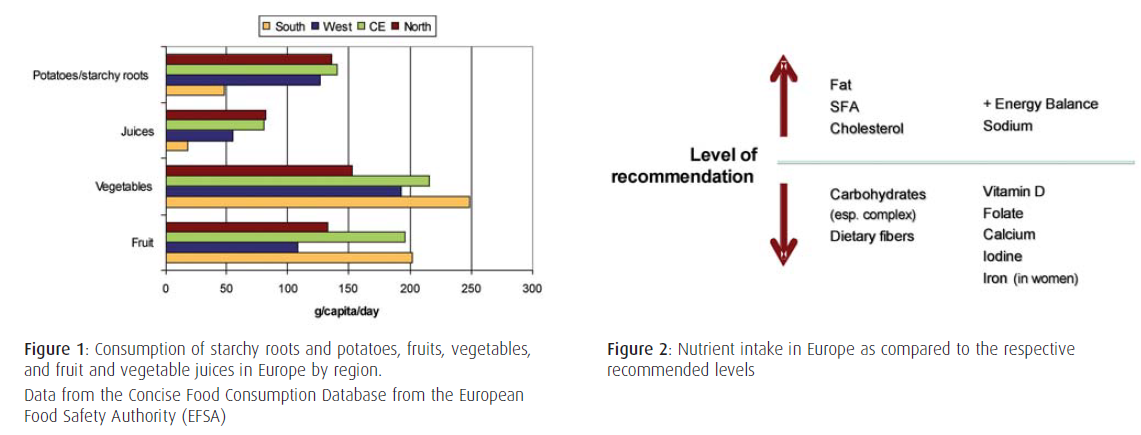Dearth in abundance – Characteristics of the current European diets – ENHR II
Unfavourable dietary habits are the main reason for the high and ever increasing prevalence of overweight and obesity in many parts of the World. At the same time, an excessive intake of energy, fat and sugar does not preclude deficiencies in essential micronutrients as repeatedly evidenced by nutritional surveys. Monitoring the population’s nutritional intake and status is important to define critical nutrients and find starting points to improve nutritional behaviour.
The European Nutrition and Health Report 2009 (ENHR II)
Accordingly, the European Nutrition and Health Report, first published in 2004, aims to give an overview of the nutrition and health situation in Europe by compiling data from individual countries using sources such as the Food Balance Sheets (FBS) of the FAO; data of the EUsupported Data Food Networking (DAFNE) project on food availability at household level derived from Household Budget Surveys and the Concise Food Consumption Database from the European Food Safety Authority (EFSA); as well as national dietary surveys.
European diets
The past decades have seen an increase in the supply of not only animal foods especially red meat, poultry, milk products, but also of vegetable oils, Fruits and Vegetables (F&V). A decline can be seen for pulses, potatoes, and to a lesser extent, for cereals. Nevertheless, the proportion of plant and animal products supplied has remained relatively stable in most regions except the South where the latter markedly increased.
From a regional point of view, the great importance of milk products in the Northern diet is salient, while F&V are less consumed. Together with the South, this region also reached the highest supply, availability, and consumption of fish. The South and especially the Central-East showed the highest levels of F&V consumption. Cereals and potatoes are consumed in highest amounts in the Central-East (see figure 1), an area that also showed high availability and consumption of meat.
Health implications
Some favourable trends do appear in the European diets over the past four décades such as a decreased supply of animal fat and an increase for fruit, vegetable and fish. Nevertheless, the intake recommendations are not being met in many ways (see figure 2). Thus, the amount of at least 400 g/d of F&V recommended by the World Health Organization was only reached in four countries, three of which were located in the Central-Eastern region.
Accordingly, mean intakes of dietary fibre and β-carotene, for which F&V present an important source, were highest in this region although the recommended intake levels were not met in many European countries. In turn, intake of folate was lowest in the Central-East and South and highest in the North. The latter, especially the Scandinavian part, also showed the highest mean calcium intakes, reflecting the high consumption of milk products, and was the only region to reach on average the recommendations for vitamin D intake. In the Central-Eastern parts, iodine intake was generally low. Critical micronutrients were broadly the same across the age classes as was the regional pattern. Calcium intake was rather low especially in children aged 10-14, which has potential importance with respect to growth and bone mass.
Overall, intake of macro- and micronutrients showed a high variability, but carbohydrate intake tended to be higher in the North and Central-East. The Southern region showed both, the highest and lowest intake levels of total fat. Intake of saturated fatty acids was generally too high, mostly accounting for >10% of energy intake. Since 1961, the contribution of fat to total energy intake as estimated from the FAO FBS increased from 30 to 35% while it decreased for carbohydrates from 58 to 53%. No change occurred for levels of protein that was constant with 12%. Data from national surveys showed that protein supply was sufficient in all countries and age groups. Energy intake was mostly below or within the reference levels of the German speaking countries and comparable between the regions.
In summary, the average diets of the European regions are rich in energy and energy-providing macronutrients, but at the same time do not contain satisfying amounts of critical nutrients and food components like folate, iodine, and dietary fibre. Consumption of F&V and, in the Central Eastern and Western regions, of fish should also be increased.

